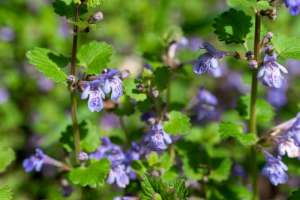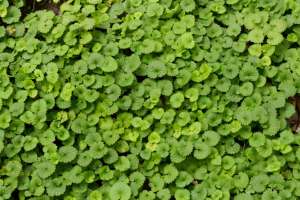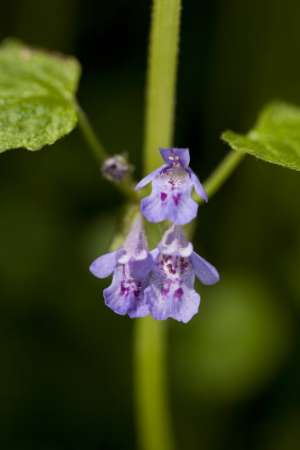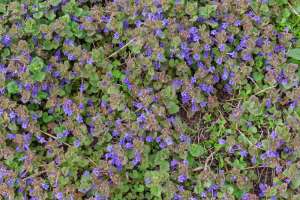Also known as Creeping Charlie and Gill-over-the-ground, ground ivy (Glechoma hederacea) is a perennial non-native invasive plant that is naturalized throughout most of North America.
Like many of our common edible weeds in the United States, it was introduced by early European settlers who brought it with them to cultivate and use medicinally.
I wouldn't say it's one of the more popular plants to forage, but it's prolific and abundant, and it can be a useful addition to your repertoire of wild edibles.

Ground ivy in bloom
Identification
Leaves
Ground ivy is a member of the Lamiaceae family, which means it's a mint. Like all mints, its leaves are arranged oppositely on square stems.
Its small 1/2 to one inch leaves are round to kidney-shaped with round-toothed or scalloped edges. The leaves are joined to the stem by long petioles, or leafstalks.
They're typically green but turn purplish in sunny areas. They're also slightly hairy.

Also characteristic of mints, Glechoma emits a distinct smell when the leaves are crushed. It's sort of a cross between mint and sage, which is sometimes described as unpleasant.
Flowers
The small purple-blue funnel-shaped flowers bloom from early-spring through early- to mid-summer.
They're usually no more than 1/2 inch long and normally occur in clusters of two or three. They grow from the leaf axils -- where the petiole meets the stem.
Each two-lipped flower has five petals.

Habitat & growth habits
Ground ivy loves damp, shady areas like the edges of woods, flower beds, etc. It also tolerates full sun, though, and will easily invade a sunny manicured lawn.
It forms dense mats by sending out runners, or stolons, just above the soil surface. Each stolon can reach up to seven feet, and each leaf node sprouts roots that fasten the stolons to the ground.
This in part is what makes ground ivy a difficult weed to eradicate. By maintaining that close-to-the-ground low profile, the main parts of the plant can easily evade mowers and weed eaters while continuing to spread.
Hence the name "Creeping Charlie" -- it silently creeps through your lawn and takes over.
After flowering, the plant puts its energy into spreading and the creeping stems grow more rapidly.
In addition to spreading by stolon, it also proliferates by seed.
It's considered a ground cover, but Glechoma hederacea can reach heights of up to 20 inches when flowering, depending on where it grows. It normally doesn't get higher than about eight inches.

Look-alikes
Henbit (Lamium amplexicaule) and Purple dead nettle (Lamium purpureum), also members of Lamiaceae, are commonly confused with ground ivy.
Henbit has three distinct differences:
- Its has fuzzier leaves.
- The upper leaves are attached directly to the stem (no petioles).
- It has a single taproot (no creeping runners that root at the nodes).
Purple dead nettle can be distinguished by these three leaf traits:
- They are more heart-shaped to triangular (less rounded and more pointed).
- Like henbit's leaves, they're fuzzy.
- The upper leaves transition from green to purple-red as they get higher on the stem.
Common mallow (Malva neglecta) is another similar looking plant that gets mistakenly identified as Glechoma, but mallow is not a mint and does not have square stems or a minty odor when crushed.
It's also sometimes confused with Common blue violet (Viola sororia), but like mallow, violet is not in the mint family and does not have square stems or a noticeable smell.
All four of these plants are edible.
Edible use
Volatile oils are what makes mint minty. They're also what gives Glechoma its unique, sometimes overpowering flavor.
Younger leaves tend to have a lower concentration of volatile oils, which means they're more mildly flavored. They're also more tender, so younger leaves are really what you want if you plan on eating them.
Eat them raw in salads or cooked like spinach.
And being aromatic, the leaves can be used as an herb for flavoring soups, casseroles, etc.
Use the leaves fresh or dried to make tea.
Caution
Glechoma is known to be toxic to some rodents and livestock, specifically horses, in large quantities.
I don't know of any research that's been done on how it may affect humans, but it should be consumed in moderation.
According to SFGATE, "it can adversely affect your digestive system if ingested in large doses."
And WebMD says it "contains a chemical that can irritate the kidneys."
Pesticides are also a concern. They're always something to be aware of when foraging, but hard-to-control lawn weeds deserve extra attention since they're more prone to being sprayed than something wild on the edge of the woods.
Traditional use
Yet another name for Glechoma hederacea is "alehoof." The "ale" in alehoof is derived from, well, ale. And "hoof" is from the Old English word "hofe," which means ivy.
Before hops were a thing in beer brewing, Glechoma was a go-to herb for clarifying, flavoring, and preserving ale, or gruit as it was called.
North American colonists used it internally and externally as a remedy for various ailments.
In England, it was believed to be a cure-all, which is why it was brought to the United States in the first place.
It was also a popular and effective ground cover.